More Pollinator Plants for Wild Yards
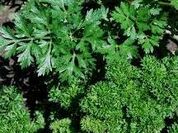 Parsley (Petroselinum crispum)
Parsley (Petroselinum crispum)
Parsley (Petroselinum crispum) This herb is biennial, but probably grown most successfully as an annual. In addition to being prized for sparking up a wide variety of dishes, parsley is the larval food plant for the Black Swallowtail Butterfly. Leave some in your herb garden to encourage these attractive pollinators. Prefers sun and does well in average soil.
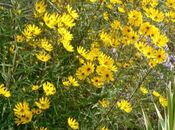 Perennial Sunflower (Helianthus divaricatus)
Perennial Sunflower (Helianthus divaricatus)
Perennial Sunflower (Helianthus divaricatus) A garden favorite for a sunny location, this 4 to 5-foot plant is loaded with 3-inch pale yellow flowers that attract butterflies. Also called woodland sunflower. Without at least 5 hours of sun per day, the plants will have a tendency to get leggy and flop over. Sunflowers in a perennial garden attract hummingbirds, butterflies, beneficial insects and birds, which help reduce harmful insect pest populations.
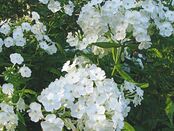 Phlox (Phlox paniculata)
Phlox (Phlox paniculata)
Phlox (Phlox paniculata) Rich, fragrant blooms open in July and continue for weeks, offering a color range in red, pink or white, and attracting a wide variety of butterflies. A Connecticut native.
Grow in moderately fertile, medium moisture, well-drained soil in full sun to part shade. Best in full sun. Prefers rich, moist, organic soils. Space well and thin out stems as needed to help combat potential powdery mildew problems. Intolerant of drought and needs to be watered in dry spells. For winter, cut plants to the ground and remove from the garden plus clean up all plant areas in order to minimize possible powdery mildew infection for the following growing season. Remove faded flower panicles to prolong bloom period and to prevent unwanted self-seeding.
Grow in moderately fertile, medium moisture, well-drained soil in full sun to part shade. Best in full sun. Prefers rich, moist, organic soils. Space well and thin out stems as needed to help combat potential powdery mildew problems. Intolerant of drought and needs to be watered in dry spells. For winter, cut plants to the ground and remove from the garden plus clean up all plant areas in order to minimize possible powdery mildew infection for the following growing season. Remove faded flower panicles to prolong bloom period and to prevent unwanted self-seeding.
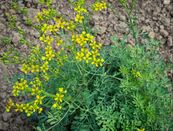 Rue (Ruta graveolens)
Rue (Ruta graveolens)
Rue (Ruta graveolens) This perennial herb has attractive silver foliage with yellow button flowers and grows to about two feet tall. It grows in sun but tolerates part shade, and grows best in a well-drained good soil of pH 7.0. Rue is easily grown from seed, though slow to germinate. Sow seeds indoors in late winter and transplant seedlings to the garden in late spring. Plants flower in their second year in midsummer. Attracts giant swallowtail butterflies.
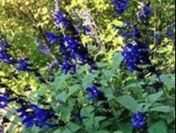 Salvia (Salvia guaranitica ‘Black & Blue’)
Salvia (Salvia guaranitica ‘Black & Blue’)
Salvia, Blue (Salvia guaranitica ‘Black & Blue’) This annual sage blooms in the late summer with one of the deepest blue flowers imaginable. Grows 3 feet to as tall as 6 feet in ideal growing conditions, producing 15-inch spikes of deep blue, two-lipped flowers from mid-summer into fall. Effective as a border, bedding or container plant, 'Black and blue' salvia offers the added benefit of attracting hummingbirds and butterflies to the garden. This low-maintenance perennial requires little care to thrive.
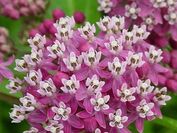 Swamp Butterfly Weed (Asclepias incarnata)
Swamp Butterfly Weed (Asclepias incarnata)
Swamp Butterfly Weed (Asclepias incarnata) This native Connecticut plant has flat-topped clusters of pink or white flowers that are irresistible to butterflies. It prefers rich, moist soil but is very adaptable in the garden. The flowers of this 2-4 foot perennial are made up of small, rose-purple flowers. Deep pink flowers clustered at the top of a tall, branching stem bear numerous narrow lance-shaped leaves. Prefers a sunny location.
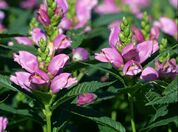 Turtlehead (Chelone lyonii)
Turtlehead (Chelone lyonii)
Turtlehead (Chelone lyonii) Resembling the shape of a turtle’s head, pink flowers bloom abundantly in the summer. Although found in wet locations, they adapt well in average soil as long as drought can be avoided. A larval food plant for the Baltimore checkerspot butterfly. They prefer a soil pH that is neutral and grows well in either full sun or part shade. Turtlehead flowers can be started from seeds indoors, by directly sowing in a boggy location or with young plants or divisions.
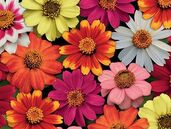 Zinnia (Zinnia spp.)
Zinnia (Zinnia spp.)
Zinnia (Zinnia spp.) A colorful favorite of every gardener, this annual is among the top butterfly nectar plants. Cut back flowers for continued bloom. Thrives in sun. Mixed colors including red, orange, yellow, white and pink. Plant the single instead of the double bloom variety. Double flowers often don’t provide nectar and pollen for bees and other pollinators.
See more flowering annual and perennial pollinator plants. And see more about shrubs to attract pollinators. More about butterflies here.